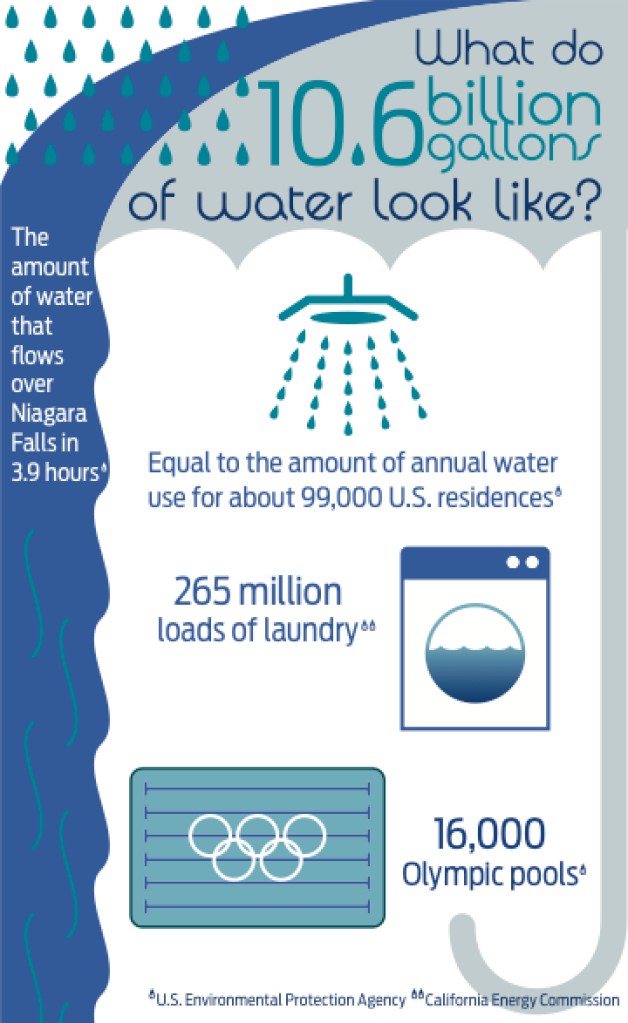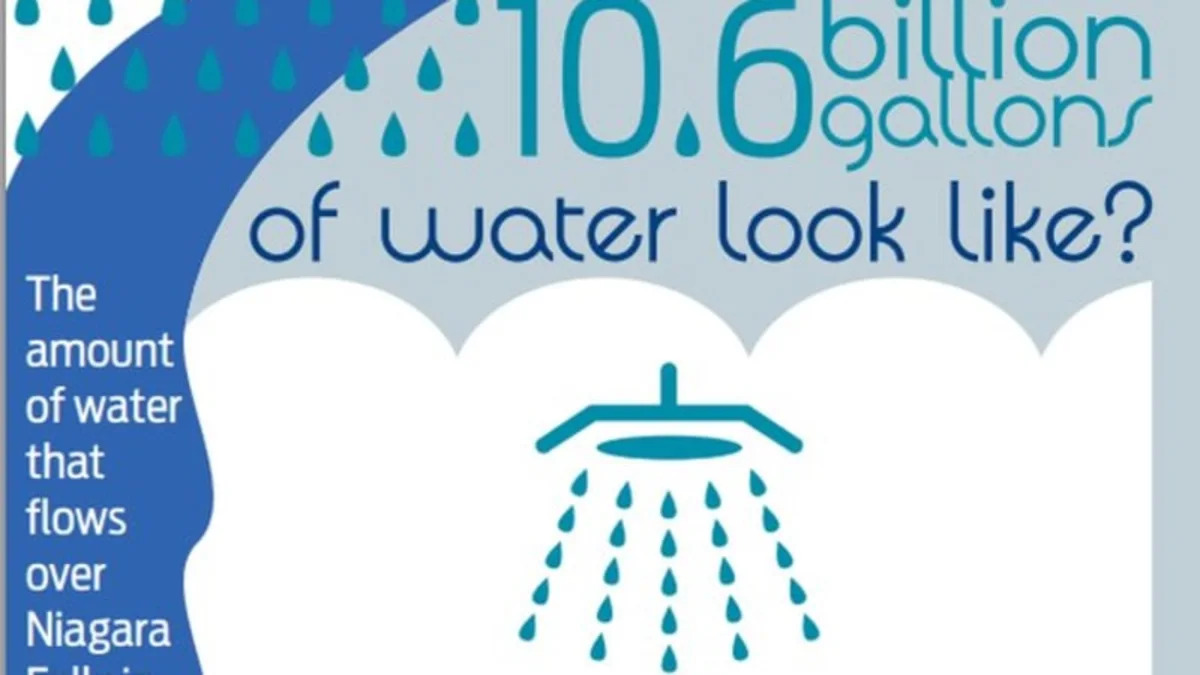Ford is reducing its water use much faster than expected, and touting the achievement with another infographic. During 2012, the global automaker achieved an 8.5 percent reduction in the amount of water used to make its vehicles, putting Ford more than halfway toward its target of using an average of four cubic meters per vehicle globally by 2015.
Ford has been working on water conservation since 2000, and so far has reduced the amount of water used for vehicle production by 10.6 billion gallons, or 62 percent. Its annual water usage has dropped from 64 million cubic meters to 24 million cubic meters during that time. Ford compares the reduction to the amount of water that could fill 16,000 Olympic-sized swimming pools or the water used by about 99,000 US homes in a year.
The methods used to reduce water use vary by plant and address everything from cooling towers to parts washing to plant operations. At its Chennai Assembly plant in India, Ford installed a new system that allows the plant to recycle all of its water. At its two assembly plants in Chongqing, China, the automaker added advanced water treatment equipment to improve recycling. The first assembly plant recycles an average of 100,000 gallons of water daily and the second plant averages 65,000 gallons daily.
Ford says that its water strategy complements the company's overall Code of Human Rights, Basic Working Conditions and Corporate Responsibilities. The water strategy also lines up with Ford's "Blueprint for Sustainability," which was started up to reduce its energy use, CO2 emissions and landfill waste.

Ford has been working on water conservation since 2000, and so far has reduced the amount of water used for vehicle production by 10.6 billion gallons, or 62 percent. Its annual water usage has dropped from 64 million cubic meters to 24 million cubic meters during that time. Ford compares the reduction to the amount of water that could fill 16,000 Olympic-sized swimming pools or the water used by about 99,000 US homes in a year.
The methods used to reduce water use vary by plant and address everything from cooling towers to parts washing to plant operations. At its Chennai Assembly plant in India, Ford installed a new system that allows the plant to recycle all of its water. At its two assembly plants in Chongqing, China, the automaker added advanced water treatment equipment to improve recycling. The first assembly plant recycles an average of 100,000 gallons of water daily and the second plant averages 65,000 gallons daily.
Ford says that its water strategy complements the company's overall Code of Human Rights, Basic Working Conditions and Corporate Responsibilities. The water strategy also lines up with Ford's "Blueprint for Sustainability," which was started up to reduce its energy use, CO2 emissions and landfill waste.

Ford Cuts Global Water Use 8.5 Percent per Vehicle from 2011 to 2012; Total Usage Down 62 Percent Since 2000
Since 2000, Ford has reduced the amount of water it uses in everything from cooling towers to parts washing and paint operations by 10.6 billion gallons, or 62 percent. That's equal to the amount of water used by nearly 99,000 U.S. residences annually, or enough to fill 16,000 Olympic-size pools. Ford's reduced consumption rates mean even more to regions around the world struggling with water-related issues like drought and extensive population growth.
Ford's water reduction success is a result of the company's commitment to reduce the amount of water it uses by aggressively monitoring and managing just about every drop of water going into and out of its facilities and properties, says Andy Hobbs, director, Environmental Quality Office.
Since 2000, Ford decreased the total amount of water used around the world annually from 64 million cubic meters to 24 million cubic meters.
"That's about 10.6 billion gallons of water that was conserved and went to use somewhere else," says Hobbs.
Ford voluntarily launched its Global Water Management Initiative in 2000, putting in place ways to manage water conservation, quality and reuse of storm and process water. Ford's water strategy complements the company's overall Code of Human Rights, Basic Working Conditions and Corporate Responsibilities.
"Ford recognizes the critical importance of water, and is committed to conserving water and using it responsibly," says Robert Brown, vice president, Sustainability, Environment and Safety Engineering. "Many vehicle manufacturing processes require water and the resource is used at every point in our supply chain."
Ford aims to use an average of 1,056 gallons of water to make each vehicle globally –consistent with its overall goal of a 30 percent reduction in the amount of water used per vehicle between 2009 and 2015. That is slightly more than the 1,000 gallons fire engine tankers in the U.S. are required to contain in their tanks. One cubic meter of water is equal to 264 gallons.
Continuing the progress
Ford had a positive impact on the world's water supply in many ways during 2012. The Ford Fund, for example, supported 19 different water-related projects in China, Indonesia, Thailand, Philippines, India, Germany and South Africa.
One project in arid Southwest China, for instance, involved 60 Ford employees from Nanjing, who helped eight families build water cellars designed to capture water during the rainy season to store and use during drier times of the year.
At the same time, Ford's biggest water-related projects were within its own facilities and included:
Minimizing water use and consumption at Ford facilities
Finding ways to use alternative, lower-quality water sources
Prioritizing water technology investments based on local water scarcity and cost effectiveness
Meeting either local quality standards or Ford global standards for wastewater discharge – whichever is more stringent at each Ford location
Ensuring a stable water supply for Ford manufacturing facilities while working with local communities to minimize impact
More information about Ford's water use-related efforts can be found in the company's annual sustainability report that is released annually every June. The most recent version can be found here.
# # #
About Ford Motor Company
Ford Motor Company, a global automotive industry leader based in Dearborn, Mich., manufactures or distributes automobiles across six continents. With about 171,000 employees and 65 plants worldwide, the company's automotive brands include Ford and Lincoln. The company provides financial services through Ford Motor Credit Company. For more information regarding Ford and its products worldwide, please visit http://corporate.ford.com.
- In late 2011, Ford announced its global water use reduction strategy would decrease the average amount of water used to make each vehicle by 30 percent between 2009 and 2015; water use already has been cut by 25 percent per vehicle since 2009
- Since 2000, Ford has decreased its total water use globally from 64 million cubic meters to 24 million cubic meters – the equivalent of about 10.6 billion gallons – due in large part to implementation of new methods for monitoring and managing how water is used at each facility
Since 2000, Ford has reduced the amount of water it uses in everything from cooling towers to parts washing and paint operations by 10.6 billion gallons, or 62 percent. That's equal to the amount of water used by nearly 99,000 U.S. residences annually, or enough to fill 16,000 Olympic-size pools. Ford's reduced consumption rates mean even more to regions around the world struggling with water-related issues like drought and extensive population growth.
Ford's water reduction success is a result of the company's commitment to reduce the amount of water it uses by aggressively monitoring and managing just about every drop of water going into and out of its facilities and properties, says Andy Hobbs, director, Environmental Quality Office.
Since 2000, Ford decreased the total amount of water used around the world annually from 64 million cubic meters to 24 million cubic meters.
"That's about 10.6 billion gallons of water that was conserved and went to use somewhere else," says Hobbs.
Ford voluntarily launched its Global Water Management Initiative in 2000, putting in place ways to manage water conservation, quality and reuse of storm and process water. Ford's water strategy complements the company's overall Code of Human Rights, Basic Working Conditions and Corporate Responsibilities.
"Ford recognizes the critical importance of water, and is committed to conserving water and using it responsibly," says Robert Brown, vice president, Sustainability, Environment and Safety Engineering. "Many vehicle manufacturing processes require water and the resource is used at every point in our supply chain."
Ford aims to use an average of 1,056 gallons of water to make each vehicle globally –consistent with its overall goal of a 30 percent reduction in the amount of water used per vehicle between 2009 and 2015. That is slightly more than the 1,000 gallons fire engine tankers in the U.S. are required to contain in their tanks. One cubic meter of water is equal to 264 gallons.
Continuing the progress
Ford had a positive impact on the world's water supply in many ways during 2012. The Ford Fund, for example, supported 19 different water-related projects in China, Indonesia, Thailand, Philippines, India, Germany and South Africa.
One project in arid Southwest China, for instance, involved 60 Ford employees from Nanjing, who helped eight families build water cellars designed to capture water during the rainy season to store and use during drier times of the year.
At the same time, Ford's biggest water-related projects were within its own facilities and included:
- Cologne Engine Plant (Germany): Decreased water use by 50 percent per engine through implementation of a dry-machining process
- Silverton Assembly Plant (South Africa): Began using a $2.5 million on-site wastewater treatment plant increasing the amount of water that can be reused by up to 15 percent
- Chennai Assembly Plant (India): Installed a new system that began operating in September and allows the plant to recycle 100 percent of its water
- Chongqing Assembly 1 and Chongqing Assembly 2 (China): Both plants added advanced water treatment equipment to improve recycling. CAF1 recycles an average 100,000 gallons daily, and CAF2 an average 65,000 gallons
- Louisville Assembly Plant (U.S.): Recently replaced parking lot asphalt with pervious paving blocks to manage stormwater runoff, helping protect nearby bodies of freshwater
Minimizing water use and consumption at Ford facilities
Finding ways to use alternative, lower-quality water sources
Prioritizing water technology investments based on local water scarcity and cost effectiveness
Meeting either local quality standards or Ford global standards for wastewater discharge – whichever is more stringent at each Ford location
Ensuring a stable water supply for Ford manufacturing facilities while working with local communities to minimize impact
More information about Ford's water use-related efforts can be found in the company's annual sustainability report that is released annually every June. The most recent version can be found here.
# # #
About Ford Motor Company
Ford Motor Company, a global automotive industry leader based in Dearborn, Mich., manufactures or distributes automobiles across six continents. With about 171,000 employees and 65 plants worldwide, the company's automotive brands include Ford and Lincoln. The company provides financial services through Ford Motor Credit Company. For more information regarding Ford and its products worldwide, please visit http://corporate.ford.com.


Sign in to post
Please sign in to leave a comment.
Continue